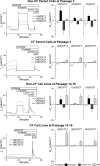Novel human bronchial epithelial cell lines for cystic fibrosis research
- PMID: 18978040
- PMCID: PMC2636952
- DOI: 10.1152/ajplung.90314.2008
Novel human bronchial epithelial cell lines for cystic fibrosis research
Abstract
Immortalization of human bronchial epithelial (hBE) cells often entails loss of differentiation. Bmi-1 is a protooncogene that maintains stem cells, and its expression creates cell lines that recapitulate normal cell structure and function. We introduced Bmi-1 and the catalytic subunit of telomerase (hTERT) into three non-cystic fibrosis (CF) and three DeltaF508 homozygous CF primary bronchial cell preparations. This treatment extended cell life span, although not as profoundly as viral oncogenes, and at passages 14 and 15, the new cell lines had a diploid karyotype. Ussing chamber analysis revealed variable transepithelial resistances, ranging from 200 to 1,200 Omega.cm(2). In the non-CF cell lines, short-circuit currents were stimulated by forskolin and inhibited by CFTR(inh)-172 at levels mostly comparable to early passage primary cells. CF cell lines exhibited no forskolin-stimulated current and minimal CFTR(inh)-172 response. Amiloride-inhibitable and UTP-stimulated currents were present, but at lower and higher amplitudes than in primary cells, respectively. The cells exhibited a pseudostratified morphology, with prominent apical membrane polarization, few apoptotic bodies, numerous mucous secretory cells, and occasional ciliated cells. CF and non-CF cell lines produced similar levels of IL-8 at baseline and equally increased IL-8 secretion in response to IL-1beta, TNF-alpha, and the Toll-like receptor 2 agonist Pam3Cys. Although they have lower growth potential and more fastidious growth requirements than viral oncogene transformed cells, Bmi-1/hTERT airway epithelial cell lines will be useful for several avenues of investigation and will help fill gaps currently hindering CF research and therapeutic development.
Figures






Similar articles
-
Cytokine secretion by cystic fibrosis airway epithelial cells.Am J Respir Crit Care Med. 2004 Mar 1;169(5):645-53. doi: 10.1164/rccm.200207-765OC. Epub 2003 Dec 11. Am J Respir Crit Care Med. 2004. PMID: 14670800
-
Augmentation of Cystic Fibrosis Transmembrane Conductance Regulator Function in Human Bronchial Epithelial Cells via SLC6A14-Dependent Amino Acid Uptake. Implications for Treatment of Cystic Fibrosis.Am J Respir Cell Mol Biol. 2019 Dec;61(6):755-764. doi: 10.1165/rcmb.2019-0094OC. Am J Respir Cell Mol Biol. 2019. PMID: 31189070
-
Development of cystic fibrosis and noncystic fibrosis airway cell lines.Am J Physiol Lung Cell Mol Physiol. 2003 May;284(5):L844-54. doi: 10.1152/ajplung.00355.2002. Epub 2003 Jan 10. Am J Physiol Lung Cell Mol Physiol. 2003. PMID: 12676769
-
Inflammation in cystic fibrosis airways: relationship to increased bacterial adherence.Eur Respir J. 2001 Jan;17(1):27-35. doi: 10.1183/09031936.01.17100270. Eur Respir J. 2001. PMID: 11307750
-
Airway and alveolar epithelial cells in culture.Eur Respir J. 2019 Nov 7;54(5):1900742. doi: 10.1183/13993003.00742-2019. Print 2019 Nov. Eur Respir J. 2019. PMID: 31515398 Review. No abstract available.
Cited by
-
Growth of human bronchial epithelial cells at an air-liquid interface alters the response to particle exposure.Part Fibre Toxicol. 2013 Jun 26;10:25. doi: 10.1186/1743-8977-10-25. Part Fibre Toxicol. 2013. PMID: 23800224 Free PMC article.
-
Long-term culture and cloning of primary human bronchial basal cells that maintain multipotent differentiation capacity and CFTR channel function.Am J Physiol Lung Cell Mol Physiol. 2018 Aug 1;315(2):L313-L327. doi: 10.1152/ajplung.00355.2017. Epub 2018 May 3. Am J Physiol Lung Cell Mol Physiol. 2018. PMID: 29722564 Free PMC article.
-
Differential Contribution of the Aryl-Hydrocarbon Receptor and Toll-Like Receptor Pathways to IL-8 Expression in Normal and Cystic Fibrosis Airway Epithelial Cells Exposed to Pseudomonas aeruginosa.Front Cell Dev Biol. 2016 Dec 22;4:148. doi: 10.3389/fcell.2016.00148. eCollection 2016. Front Cell Dev Biol. 2016. PMID: 28066767 Free PMC article.
-
Human models for COVID-19 research.J Physiol. 2021 Sep;599(18):4255-4267. doi: 10.1113/JP281499. Epub 2021 Aug 17. J Physiol. 2021. PMID: 34287894 Free PMC article.
-
Airway epithelial stem cell renewal and differentiation: overcoming challenging steps towards clinical-grade tissue engineering.Stem Cell Res Ther. 2025 Jul 6;16(1):351. doi: 10.1186/s13287-025-04478-0. Stem Cell Res Ther. 2025. PMID: 40619403 Free PMC article.
References
-
- Alkema MJ, van der Lugt NM, Bobeldijk RC, Berns A, van Lohuizen M. Transformation of axial skeleton due to overexpression of bmi-1 in transgenic mice. Nature 374: 724–727, 1995. - PubMed
-
- Bea S, Tort F, Pinyol M, Puig X, Hernandez L, Hernandez S, Fernandez PL, van Lohuizen M, Colomer D, Campo E. BMI-1 gene amplification and overexpression in hematological malignancies occur mainly in mantle cell lymphomas. Cancer Res 61: 2409–2412, 2001. - PubMed
-
- Becker MN, Sauer MS, Muhlebach MS, Hirsh AJ, Wu Q, Verghese MW, Randell SH. Cytokine secretion by cystic fibrosis airway epithelial cells. Am J Respir Crit Care Med 169: 645–653, 2004. - PubMed
-
- Benali R, Tournier JM, Chevillard M, Zahm JM, Klossek JM, Hinnrasky J, Gaillard D, Maquart FX, Puchelle E. Tubule formation by human surface respiratory epithelial cells cultured in a three-dimensional collagen lattice. Am J Physiol Lung Cell Mol Physiol 264: L183–L192, 1993. - PubMed
-
- Boers JE, Ambergen AW, Thunnissen FB. Number and proliferation of basal and parabasal cells in normal human airway epithelium. Am J Respir Crit Care Med 157: 2000–2006, 1998. - PubMed
Publication types
MeSH terms
Substances
Grants and funding
LinkOut - more resources
Full Text Sources
Other Literature Sources
Medical
Molecular Biology Databases
Research Materials

